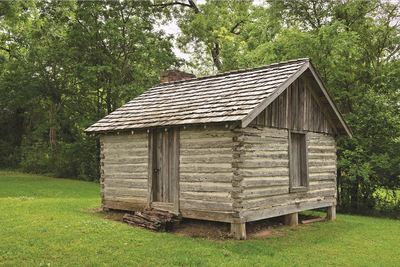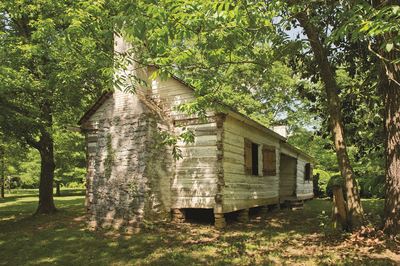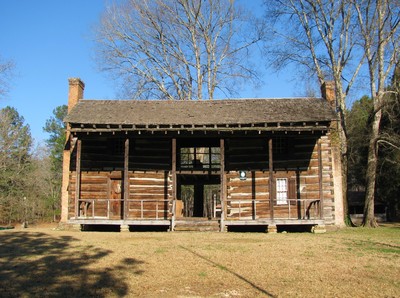While most settlers who descended on the Alabama Territory hoped to carve farms and plantations from their little corners of the future state, others pursued a more urban vision of the path to prosperity. The year 1818 featured some of the Alabama Territory’s most frenzied and optimistic speculation, investment, and general dreaming and scheming in this regard. In one of the most elaborate examples of a common territorial phenomenon, for example the Cypress Land Company offered the first lots for sale in the planned city of Florence on July 22.
Envisioned as the “entrepôt of the Tennessee,” the city-to-be was located strategically at the Muscle Shoals, the head of the river’s regular navigation, and was named in honor of the Italian hometown of Ferdinand Sannoner, who laid out its wide boulevards, public parks, and attractive riverside lots. Men of local and national standing, including former and future presidents James Madison and Andrew Jackson, backed the undertaking financially. The driving force behind Florence’s birth, though, was war hero and businessman John Coffee, who managed to translate a government appointment as surveyor into a coveted position as primary keeper of knowledge on the economic potential of some of Alabama’s most desirable real estate. By brokering information and capital, Coffee thus became one of several entrepreneurs shaping the beginnings of some of Alabama’s leading population centers.
Speculative city-founding became something of a competitive hobby in the Alabama Territory, and almost as many towns were planned in the tumultuous territorial period as organically developed and survived in the state of Alabama. Enterprising individuals planned a number of long-vanished communities during the era. Urban prospecting became so pervasive in the territory that in summer 1818, the Mobile Gazette carried a poetic parody of speculative Alabama city-building:
Speculative city-founding became something of a competitive hobby in the Alabama Territory, and almost as many towns were planned in the tumultuous territorial period as organically developed and survived in the state of Alabama. Enterprising individuals planned a number of long-vanished communities during the era. Urban prospecting became so pervasive in the territory that in summer 1818, the Mobile Gazette carried a poetic parody of speculative Alabama city-building:
What own a city! You exclaim,
Yes own the spot, that’s just the same,
On which the place must stand;
For if on maps it’s once laid down,
It is a genuine a town,
As any in the land.
A few planned cities did take root and thrive, some surviving to this day and others barely through the era. For example, Selma and Cahawba (later known as Cahaba), the future capital, were laid out during the territorial years on promising spots previously occupied by lone settlers. In the territory’s extreme southern portion, Blakeley, envisioned by its namesake founder as a cross-bay competitor to Mobile for its deepwater port, briefly bloomed along the Tensaw River before a host of setbacks doomed it to becoming a ghost town. In fall 1818 it even drew the attention of the nationally circulated Niles Weekly Register, which reported that the “place where the city of Blakeley now stands was, at this time last year, covered with a thick heavy forest, with no inhabitants and but one house—it is now said to have 80 houses, 10 large warehouses, and the largest hotel in the territory, with from 300 to 500 inhabitants.”
The Register’s article could have largely described a number of the Alabama Territory’s upstart urban centers. In the Tennessee Valley, the territorial metropolis of Huntsville, easily among Alabama’s most established in appearance, with its many brick houses and store-flanked town square, had been in existence less than a decade. Along the Black Warrior River, the coalescing community at the river’s falls, the future Tuscaloosa, was a mere grouping of log cabins in 1818 but a destination to which, according to one resident, “people from Tennessee were arriving daily.” That year on the mighty Alabama River, swiftly settled, planned towns near the site of venerable Indian villages began moving towards consolidation as the city of Montgomery. On the Tombigbee River, the formerly isolated colonial outpost of St. Stephens precipitously assumed a position as primary urban center for one of the territory’s longest-established pockets of American settlement and boasted all the hallmarks of a true city of the age—numerous houses, respectable stores, professional doctor’s and lawyer’s offices, commodious hotels, lively taverns, and a printing office. Even relatively ancient Mobile, long a quintessential lagging colonial base established at the beginning of the previous century, boasted the signs of a new era of growth. In a few short years, an explosion of new construction would transform the sleepy military outpost into a burgeoning American trading colossus. Many of these developing communities would mark their arrival by the establishment of their own newspapers—no mean feat in an age when the primary public source of news for Americans lay in daily and weekly broadsheets. Papers had been established within what became Alabama as early as 1811, but between 1816 and 1819, at least ten were created in its emerging principal cities.
The neatly arranged grid of streets on various early Alabama town plans and the definitive dots on period maps interpreting these newly minted or lately thriving cities as established urban entities tends to suggest something far more substantial than what actually existed, however. The Alabama Territory’s cities were decidedly humble, even ramshackle, mostly wooden affairs as compared to communities a generation later. True, frame and brick houses were rising up on town lots in increasing numbers, but a large portion of Alabama residents, whether in rural settings or even its larger towns, resided in simple log cabins. They commonly served as the ad hoc, transitory first step on the way to something more permanent, their simple and hasty construction mimicked by the unpretentious courthouses, jails, stores, and offices that formed the core of so many early communities. The paucity of construction which survives from the time period today leaves a considerably distorted concept of the appearance of the Alabama Territory’s built environment—there were far more homes on the scale of the Hickman Cabin at Pond Spring or Ashville’s Looney House than grand estates such as Huntsville’s Pope Mansion or Weeden House.
Contrary to common assumption, one building not found in most of those founding communities was a church. Alabama’s founders were certainly not areligious, but organized religion did not play a prominent part in daily life on the rugged frontier. With bare survival preoccupying the territory’s citizens, perhaps as few as one in twenty belonged to a church at all. Those that did worship as a group usually met in homes or public buildings, as it would be well into the 1820s, during the relative stability of the early years of statehood, before significant numbers of church buildings began springing up across the state. The missionaries who crisscrossed Alabama during its formative days helped plant the seeds of spirituality among its people. They consistently reported, as did ministers James L. Sloss and Hiland Hubbard in the fall of 1818, its settlements to be “entirely destitute of preaching, but very anxious to hear the word, and to obtain the labours [sic] of a minister.” As Alabama approached statehood, men such as these increasingly provided those opportunities via the famed wilderness camp meetings to which so many of the state’s earliest congregations can be traced. But even as Alabamians were coming together in towns, backwoods settlements, and newly formed institutions, sectional divisions that would threaten its growth were taking shape.
The Register’s article could have largely described a number of the Alabama Territory’s upstart urban centers. In the Tennessee Valley, the territorial metropolis of Huntsville, easily among Alabama’s most established in appearance, with its many brick houses and store-flanked town square, had been in existence less than a decade. Along the Black Warrior River, the coalescing community at the river’s falls, the future Tuscaloosa, was a mere grouping of log cabins in 1818 but a destination to which, according to one resident, “people from Tennessee were arriving daily.” That year on the mighty Alabama River, swiftly settled, planned towns near the site of venerable Indian villages began moving towards consolidation as the city of Montgomery. On the Tombigbee River, the formerly isolated colonial outpost of St. Stephens precipitously assumed a position as primary urban center for one of the territory’s longest-established pockets of American settlement and boasted all the hallmarks of a true city of the age—numerous houses, respectable stores, professional doctor’s and lawyer’s offices, commodious hotels, lively taverns, and a printing office. Even relatively ancient Mobile, long a quintessential lagging colonial base established at the beginning of the previous century, boasted the signs of a new era of growth. In a few short years, an explosion of new construction would transform the sleepy military outpost into a burgeoning American trading colossus. Many of these developing communities would mark their arrival by the establishment of their own newspapers—no mean feat in an age when the primary public source of news for Americans lay in daily and weekly broadsheets. Papers had been established within what became Alabama as early as 1811, but between 1816 and 1819, at least ten were created in its emerging principal cities.
The neatly arranged grid of streets on various early Alabama town plans and the definitive dots on period maps interpreting these newly minted or lately thriving cities as established urban entities tends to suggest something far more substantial than what actually existed, however. The Alabama Territory’s cities were decidedly humble, even ramshackle, mostly wooden affairs as compared to communities a generation later. True, frame and brick houses were rising up on town lots in increasing numbers, but a large portion of Alabama residents, whether in rural settings or even its larger towns, resided in simple log cabins. They commonly served as the ad hoc, transitory first step on the way to something more permanent, their simple and hasty construction mimicked by the unpretentious courthouses, jails, stores, and offices that formed the core of so many early communities. The paucity of construction which survives from the time period today leaves a considerably distorted concept of the appearance of the Alabama Territory’s built environment—there were far more homes on the scale of the Hickman Cabin at Pond Spring or Ashville’s Looney House than grand estates such as Huntsville’s Pope Mansion or Weeden House.
Contrary to common assumption, one building not found in most of those founding communities was a church. Alabama’s founders were certainly not areligious, but organized religion did not play a prominent part in daily life on the rugged frontier. With bare survival preoccupying the territory’s citizens, perhaps as few as one in twenty belonged to a church at all. Those that did worship as a group usually met in homes or public buildings, as it would be well into the 1820s, during the relative stability of the early years of statehood, before significant numbers of church buildings began springing up across the state. The missionaries who crisscrossed Alabama during its formative days helped plant the seeds of spirituality among its people. They consistently reported, as did ministers James L. Sloss and Hiland Hubbard in the fall of 1818, its settlements to be “entirely destitute of preaching, but very anxious to hear the word, and to obtain the labours [sic] of a minister.” As Alabama approached statehood, men such as these increasingly provided those opportunities via the famed wilderness camp meetings to which so many of the state’s earliest congregations can be traced. But even as Alabamians were coming together in towns, backwoods settlements, and newly formed institutions, sectional divisions that would threaten its growth were taking shape.



 RSS Feed
RSS Feed